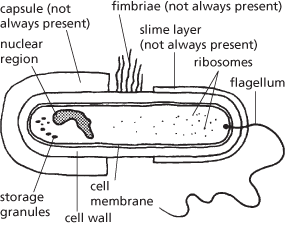A domain of life containing a diverse group of ubiquitous microorganisms all of which consist of only a single cell that lacks a distinct nuclear membrane and has a cell wall of a unique composition (see illustration). Bacteria constitute the prokaryotic organisms of the living world. However, their classification is a controversial issue. It is now recognized, on the basis of differences in ribosomal RNA structure and nucleotide sequences (see molecular systematics), that prokaryotes form two evolutionarily distinct domains: Archaea (the archaea) and Bacteria. Defining characteristics of bacteria include the possession of cell walls containing peptidoglycan, and membrane lipids containing fatty acids in ester linkage to glycerol, whereas archaea lack peptidoglycan and have ether-linked lipids. However, in general parlance, the term ‘bacteria’ can still, erroneously, encompass both archaea and bacteria.
Bacteria can be characterized in a number of ways, for example by their reaction with Gram’s stain, their GC content, or on the basis of their metabolic requirements (e.g. whether or not they require oxygen: see aerobic respiration; anaerobic respiration) and shape. A bacterial cell may be spherical (see coccus), rodlike (see bacillus), spiral (see spirillum), comma-shaped (see vibrio), corkscrew-shaped (see spirochaete), or filamentous, resembling a fungal cell. The majority of bacteria range in size from 0.5 to 5 μm. Many are motile, bearing flagella, possess an outer slimy capsule, and produce resistant spores (see endospore). In general bacteria reproduce only asexually, by simple division of cells, but a few groups undergo a form of sexual reproduction (see conjugation) and lateral gene transfer is common. Bacteria are largely responsible for decay and decomposition of organic matter, producing a cycling of such chemicals as carbon (see carbon cycle), oxygen, nitrogen (see nitrogen cycle), and sulphur (see sulphur cycle). A few bacteria obtain their food by means of photosynthesis, including the Cyanobacteria; some are saprotrophs; and others are parasites, causing disease. The symptoms of bacterial infections are produced by toxins.

A generalized bacterial cell
http://www.textbookofbacteriology.net/ Online textbook of bacteriology devised by Kenneth Todar, University of Wisconsin-Madison
One of the three taxonomic domains into which all living organisms are divided, comprising eleven groups of prokaryotes, most of which are single-celled, have a rigid cell wall, and usually reproduce by binary fission. The groups are: purple (photosynthetic); gram positive; cyanobacteria; green non-sulphur; spirochaetes; flavobacteria; green sulphur; Planctomyces; Chlamydiales; Deinococci; and Thermatogales. The only feature common to all bacteria is their prokaryotic cellular organization. Mitosis never occurs. Bacteria are almost universal in distribution and may live as saprotrophs, parasites, symbionts, pathogens, etc. They have many important roles in nature, e.g. as agents of decay and mineralization, and in the recycling of elements (such as nitrogen) in the biosphere. Bacteria are also important to humans, e.g. as causal agents of certain diseases, as agents of spoilage of food and other commodities, and as useful agents in the industrial production of commodities such as vinegar, antibiotics, and many types of dairy products. The oldest fossils known are of bacteria, from rocks in S. Africa that are apparently 3200 million years old. These must have been heterotrophic bacteria, feeding off organic molecules dissolved in the oceans of that time. The first photosynthetic bacteria, of anaerobic type, appeared a little later, about 3000 Ma ago.
- Paris, Congress of (1856)
- parish
- Paris Observatory
- Paris, Pact of
- Paris, Peace of (1783)
- Paris Peace Settlement
- Paris, Treaty of (1763)
- parity
- parity bit
- parity check
- parity-check code
- parivincular
- park
- Parker, Matt (1980– )
- Parker, Robert Allan Ridley (1936– )
- Parker Solar Probe
- Parkes, Alexander
- Parkes Observatory
- Parkes process
- parking orbit
- parking spot
- Park, Mungo (1771–1806)
- Parlement
- Parliament, British
- Parlog